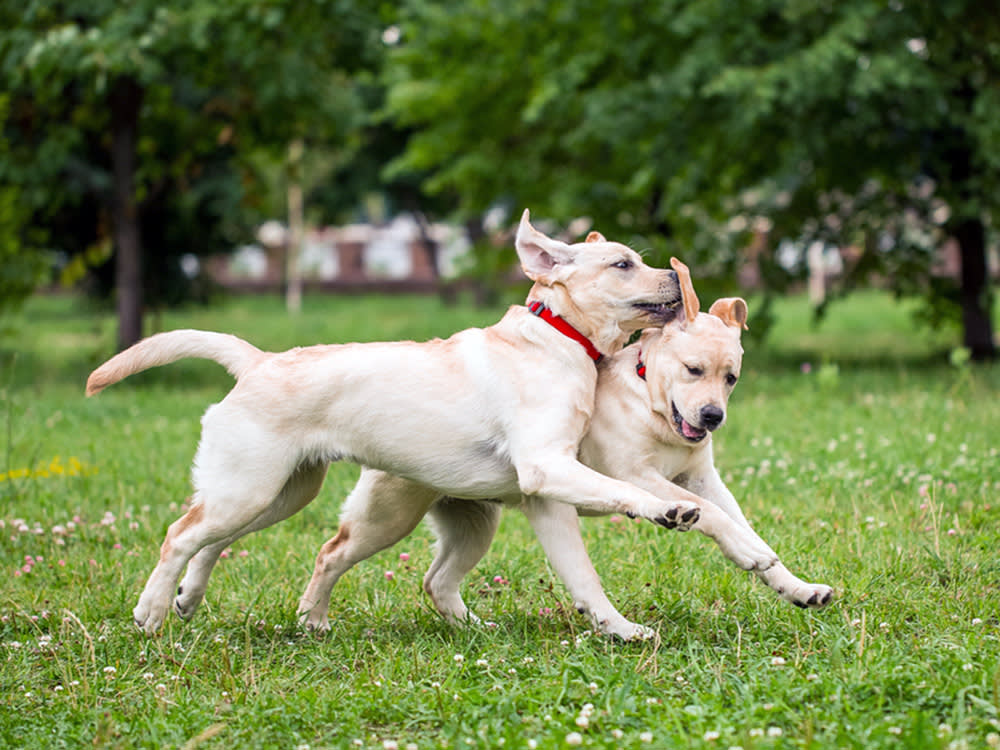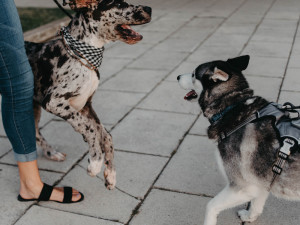Can Dogs Get Concussions?
Yes, and the signs can be subtle. Here’s what to look out for.
In This Article:
What Can Cause a Dog Concussion? Signs of Concussion in Dogs Dog Concussion Treatment When Should You Bring a Dog to a Vet for a Concussion? Frequently Asked Questions
Dogs can and do get concussions and other head injuries, so it’s important to know how to recognize the signs. These injuries often result from trauma, including accidents, collisions, and bite injuries. Recognizing the signs of head trauma is crucial so you can get your pup prompt veterinary attention and proper care.
Head injuries may result in different kinds of damage, including skull fractures, swelling of the brain (also called edema), bleeding in or around the brain, and/or damage to the brain tissue itself. A concussion is technically defined as an injury in which a person or animal loses consciousness temporarily due to rapid movement of the head and brain during trauma. There is no obvious damage to the skull or brain tissue in these cases, so it’s considered a mild brain injury and is not usually life-threatening.
However, the effects can still be scary to observe and take time to heal. In most cases, a pet parent will not know whether their dog has suffered a concussion or another type of head injury, because the signs can be similar at first. Without advanced imaging such as a CT scan, the exact nature of the injuries cannot usually be determined.
What can cause a dog concussion?
Concussions happen when there is a traumatic force strong enough to cause the brain to move within the skull. This requires a significant amount of force. In young puppies and small-breed dogs, it takes less force to cause injury. Some of the most common causes for a concussion and other similar head injuries include:
How much do you spend on your pet per year?
Car accidents
Dogs who are hit by cars or are inside of a car during a car collision are at a high risk for head injuries. The force of these accidents is strong enough to cause more severe head injuries including skull fractures, bleeds, and brain swelling too.
Dog fights
Head trauma can also occur during intense dog fights, especially if there is a size discrepancy between the animals. In this case, a larger dog can more easily bite a smaller dog’s head or shake them vigorously.
Falls
If a dog falls a long distance, they are at high risk for head trauma as well. This is often seen when dogs fall from balconies or decks. In small dogs, it can occur within the home after falling off a couch or counter, or down the stairs, too.
Other causes
Other more unusual accidents can also lead to head trauma when there is enough force involved. Some of these include small dogs or puppies being accidentally stepped on, folded up inside sofa beds or reclining chairs, intentional injuries inflicted by people on dogs, gun-shot wounds, and more.
Signs of concussion in dogs
If your dog experiences a severe trauma, such as any of those listed above, it is important to seek veterinary care immediately, even if you do not observe any initial signs of injury. Some signs can be very subtle at first and early treatment can help to prevent more serious complications.
You or your vet may observe signs that suggest head trauma but without additional testing, it is not usually clear right away if these signs are due to a concussion or other forms of head trauma. General signs of head trauma include:
Loss of consciousness
Dogs with head trauma may be fully unconscious or have modified states of awareness. Typically after a concussion, a pup would be unconscious for 30 minutes or less. If they are unconscious for a longer period of time, it is more suggestive of a more serious form of head trauma.
Pupils are different sizes
This is technically called anisocoria and is potentially a sign of head and/or neck trauma. It can also occur for other reasons unrelated to trauma.
Rapid eye movements
This is known as nystagmus and usually indicates a problem with the parts of the brain and nerves that control balance, known as the vestibular system.
Pupils not responsive to movement or light
Dogs can experience temporary or permanent blindness after head trauma, so this is an important change to note.
Changes in gait
After head trauma, some dogs may have trouble getting up and walking. This can include falling over, stumbling, walking in circles, or being unable to walk at all.
Lethargy
Dogs may be very lethargic after experiencing head trauma. This can be due to changes in their level of consciousness, an altered mental state, pain, as well as other injuries, bleeding, and/or shock.
Vomiting
Dogs may vomit as a result of head trauma. This often happens if they have other signs of vestibular problem or disruptions in balance, as this leads to feelings of dizziness and nausea.
Seizures
Head trauma can put dogs at risk for seizures, both in the short-term and in the long-term. They should be closely monitored after head trauma for any seizure activity and treated immediately if they have them.
Dog concussion treatment
It’s worth reiterating that any dog that experiences a severe trauma should be examined by a veterinarian right away. When they are injured by a strong force, they often have a combination of injuries that can affect their lungs and other internal organs in addition to head trauma, so getting them evaluated and treated right away is always warranted.
Many of the treatments for head trauma also require more advanced equipment and medications than a pet parent will have on-hand. In order to properly stabilize them and treat their signs, they need to be seen at a vet clinic.
There are some ways to help comfort your pet on the way to the vet clinic, which include:
Elevate the head
If possible, have your dog lay on their side and gently elevate your dog’s head by approximately 30 degrees using a towel or blanket. This helps to increase blood flow in and out of the brain and may help minimize swelling. Be sure your dog’s neck is not kinked in the process, as this can have the opposite effect. Try to gently extend your their head and neck if they allow it.
Reduce stimulation
Dogs with head trauma may be more sensitive to lights and sounds. Try to provide a quiet, dim setting for them on the way to the vet.
Nothing by mouth
If your dog is not fully conscious, do not attempt to give them any food, water, or medications by mouth as they could choke.
Beware of other injuries
If your dog is not fully conscious or able to walk, you may not know whether or not they have additional injuries such as broken limbs. Try to be as gentle as possible when handling and moving them and use a carrier, a blanket, or a sling, to transport them.
When should you bring a dog to a vet for a concussion?
Any dog who suffers a major trauma like being hit by a car, taking a big fall, being in a dog fight, or being stepped on, should be evaluated by a veterinarian right away. Many signs of trauma are not obvious from the outside but can cause severe complications throughout the body including bruising to the lungs, and/or internal bleeding.
The same is true for head trauma; the signs may not be obvious at first but your vet can evaluate your pooch for more subtle signs of a brain injury. These kinds of injuries require more advanced equipment and medication to treat them initially. Your dog may need supplemental oxygen, strong pain medications, anti-seizure medications, and procedures to treat their injuries.
Additionally, if you ever notice neurological abnormalities with your dog, even if there was no obvious trauma, it is still important to get them checked out right away. This includes changes in their level of consciousness, stumbling, inability to walk, seizures, loss of vision, or any other changes.
While these signs may not always be consistent with a concussion, they are signs of a problem that requires medical attention right away. The good news is that dogs with mild head trauma, such as a concussion, tend to improve rapidly, often within 24 to 48 hours. If they are making steady progress, there is a good chance for a complete recovery.
FAQs (People also ask):
How can you tell if your dog is sick?
General signs of illness include changes in your dog’s behavior and/or physical signs of illness. This often includes changes in appetite, lethargy, hiding, vomiting, diarrhea, coughing, sneezing, difficulty breathing, changes in urination or defecation, and more.
When is dog play too rough?
When your dog is playing with others, watch their body language and vocalizations for signs that their actions are playful, versus more aggressive. Any time you feel your dog or someone else’s is in danger of getting hurt, it’s a good idea to safely redirect the dogs, distract them, and/or break up the play session.













